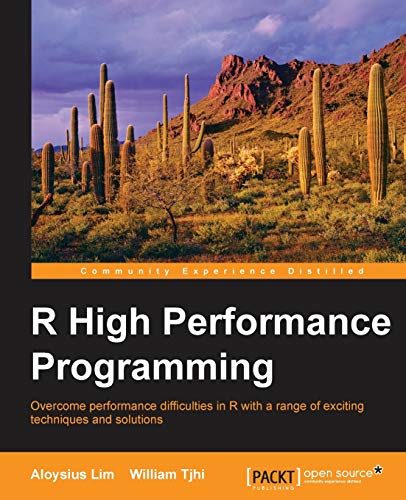

Most ebook files are in PDF format, so you can easily read them using various software such as Foxit Reader or directly on the Google Chrome browser.
Some ebook files are released by publishers in other formats such as .awz, .mobi, .epub, .fb2, etc. You may need to install specific software to read these formats on mobile/PC, such as Calibre.
Please read the tutorial at this link. https://ebooknice.com/page/post?id=faq
We offer FREE conversion to the popular formats you request; however, this may take some time. Therefore, right after payment, please email us, and we will try to provide the service as quickly as possible.
For some exceptional file formats or broken links (if any), please refrain from opening any disputes. Instead, email us first, and we will try to assist within a maximum of 6 hours.
EbookNice Team

Status:
Available4.4
41 reviews(Ebook) R High Performance Programming 1st Edition by Aloysius Lim, William Tjhi - Ebook PDF Instant Download/Delivery: 9781783989263 ,1783989262
Full download (Ebook) R High Performance Programming 1st Edition after payment

Product details:
ISBN 10: 1783989262
ISBN 13: 9781783989263
Author: Aloysius Lim, William Tjhi
This book is for programmers and developers who want to improve the performance of their R programs by making them run faster with large data sets or who are trying to solve a pesky performance problem.
(Ebook) R High Performance Programming 1st Edition Table of contents:
1. Understanding R's Performance – Why Are R Programs Sometimes Slow?
Three constraints on computing performance – CPU, RAM, and disk I/O
R is interpreted on the fly
R is single-threaded
R requires all data to be loaded into memory
Algorithm design affects time and space complexity
Summary
2. Profiling – Measuring Code's Performance
Measuring total execution time
Measuring execution time with system.time()
Repeating time measurements with rbenchmark
Measuring distribution of execution time with microbenchmark
Profiling the execution time
Profiling a function with Rprof()
The profiling results
Profiling memory utilization
Monitoring memory utilization, CPU utilization, and disk I/O using OS tools
Identifying and resolving bottlenecks
Summary
3. Simple Tweaks to Make R Run Faster
Vectorization
Use of built-in functions
Preallocating memory
Use of simpler data structures
Use of hash tables for frequent lookups on large data
Seeking fast alternative packages in CRAN
Summary
4. Using Compiled Code for Greater Speed
Compiling R code before execution
Compiling functions
Just-in-time (JIT) compilation of R code
Using compiled languages in R
Prerequisites
Including compiled code inline
Calling external compiled code
Considerations for using compiled code
R APIs
R data types versus native data types
Creating R objects and garbage collection
Allocating memory for non-R objects
Summary
5. Using GPUs to Run R Even Faster
General purpose computing on GPUs
R and GPUs
Installing gputools
Fast statistical modeling in R with gputools
Summary
6. Simple Tweaks to Use Less RAM
Reusing objects without taking up more memory
Removing intermediate data when it is no longer needed
Calculating values on the fly instead of storing them persistently
Swapping active and nonactive data
Summary
7. Processing Large Datasets with Limited RAM
Using memory-efficient data structures
Smaller data types
Sparse matrices
Symmetric matrices
Bit vectors
Using memory-mapped files and processing data in chunks
The bigmemory package
The ff package
Summary
8. Multiplying Performance with Parallel Computing
Data parallelism versus task parallelism
Implementing data parallel algorithms
Implementing task parallel algorithms
Running the same task on workers in a cluster
Running different tasks on workers in a cluster
Executing tasks in parallel on a cluster of computers
Shared memory versus distributed memory parallelism
Optimizing parallel performance
Summary
9. Offloading Data Processing to Database Systems
Extracting data into R versus processing data in a database
Preprocessing data in a relational database using SQL
Converting R expressions to SQL
Using dplyr
Using PivotalR
Running statistical and machine learning algorithms in a database
Using columnar databases for improved performance
Using array databases for maximum scientific-computing performance
Summary
10. R and Big Data
Understanding Hadoop
Setting up Hadoop on Amazon Web Services
Processing large datasets in batches using Hadoop
Uploading data to HDFS
Analyzing HDFS data with RHadoop
Other Hadoop packages for R
Summary
Index
People also search for (Ebook) R High Performance Programming 1st Edition:
high performance programmer
v r performance
hvr performance
high performance functional programming
high performance code
Tags: Aloysius Lim, William Tjhi, R High Performance, Programming